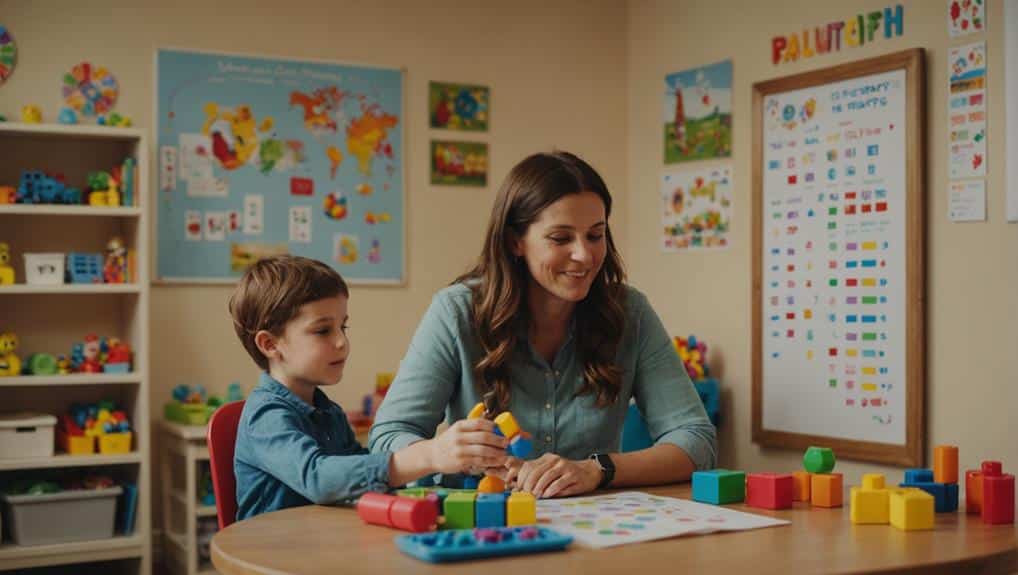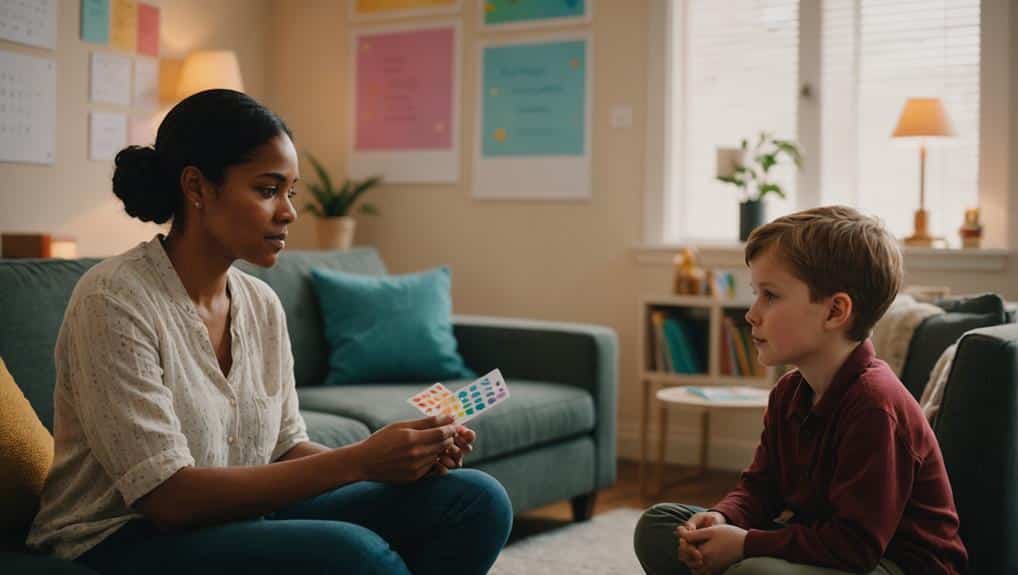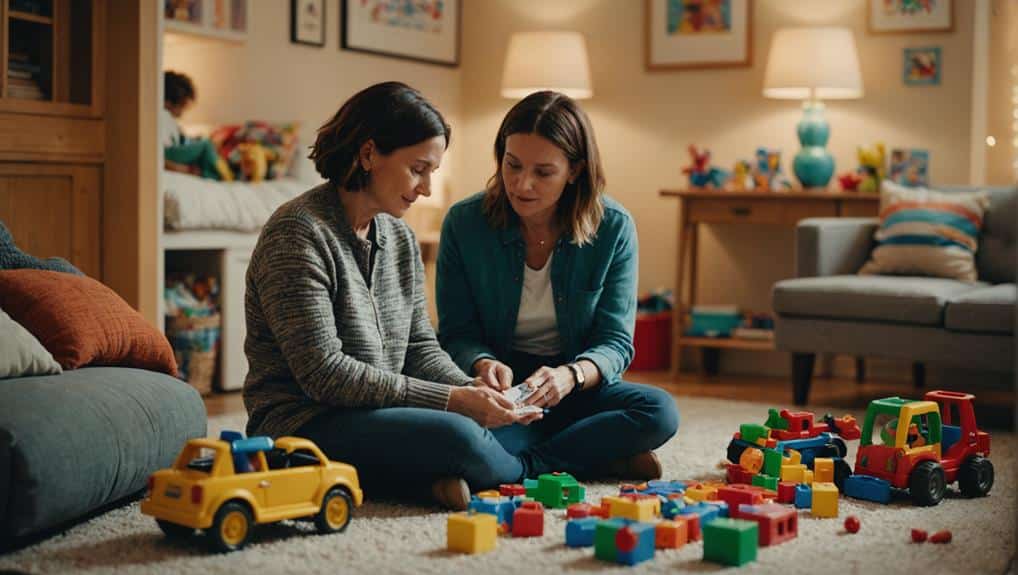Transforming autism therapy is most effective with targeted, evidence-based strategies. Early intervention maximizes developmental benefits using peak brain plasticity and positive reinforcement to foster skill acquisition. Speech therapy enhances verbal and non-verbal communication, while pediatric occupational therapy focuses on motor coordination and sensory integration. Social skills training improves interactions through structured activities and modeling.
DIR/Floortime encourages emotional connection and development through play, focusing on the child’s interests. Parent training equips caregivers with essential strategies, significantly impacting the child’s progress. Each method offers distinct yet interlinked benefits, providing thorough support for children with autism spectrum disorder. These approaches transform autism therapy, helping children develop essential life skills and navigate daily routines. Parents can use these evidence-based strategies to help their children flourish within the autism spectrum.
Key Takeaways
- Initiate early intervention before age 3 to leverage peak brain plasticity for optimal developmental outcomes.
- Utilize Applied Behavior Analysis (ABA) to set measurable goals and use positive reinforcement for skill-building.
- Enhance communication skills with speech therapy, incorporating AAC devices, visual supports, and alternative communication methods.
- Implement occupational therapy to improve motor coordination, sensory processing, and daily living skills for greater independence.
- Conduct targeted social skills training using social stories, peer-mediated interventions, and role-playing for better social interactions.
Early Intervention is a Critical
Early intervention is a critical component in autism therapy, proven to enhance significantly developmental outcomes for children diagnosed with Autism Spectrum Disorder (ASD).
The research underscores the importance of initiating therapeutic interventions before age 3, when the brain’s plasticity is at its peak. This early start fosters significant social communication and language development improvements.
Empirical evidence highlights that children who receive early intervention services exhibit marked progress in their adaptive behaviors and cognitive abilities. These programs are designed to address specific challenges associated with autism, such as difficulties in social interaction, behavior regulation, and effective communication. Early intervention strategies are tailored to meet each child’s distinct needs, ensuring a comprehensive approach to their development.
Moreover, the proven benefits of early intervention extend beyond immediate developmental milestones. They lay a robust foundation for long-term success, improving the overall quality of life for children with ASD and their families.
The effectiveness of early intervention in autism therapy is widely recognized by experts, making it a cornerstone in the support and treatment of individuals with ASD. This proactive approach exemplifies the profound impact of timely, evidence-based interventions in transforming lives.
Applied Behavior Analysis (ABA)

Applied Behavior Analysis (ABA) is an evidence-based approach that focuses on setting measurable goals and using rewards to reinforce positive behaviors, thereby improving social and life skills in individuals with autism.
By breaking down complex skills into manageable steps, ABA facilitates skill-building in a structured and systematic manner.
Research consistently supports its effectiveness in enhancing communication, social interaction, and daily living skills, making it a critical component of autism therapy.
Measurable Goals and Rewards
Setting measurable objectives in Applied Behavior Analysis (ABA) is crucial for tracking and fostering progress in people with autism, providing a structured method to assess and enhance their development. ABA therapy focuses on establishing clear, quantifiable aims that enable therapists and caregivers to evaluate the effectiveness of interventions. These measurable objectives are essential in addressing social skills, communication, and behavioral skills, ensuring that individuals with autism receive tailored support for their needs.
Incorporating rewards into ABA therapy serves as positive reinforcement, which has been shown to enhance desired behaviors significantly. Rewards motivate individuals with autism, making learning more engaging and encouraging the repetition of positive actions. This approach not only supports skill development but also aids in the maintenance of acquired behaviors over time.
Progress tracking is an essential component of ABA, allowing for continuous monitoring and adjustment of interventions to optimize outcomes. By systematically measuring progress, therapists can fine-tune their strategies to support the development of individuals with autism better.
The structured nature of ABA, with its emphasis on measurable objectives and rewards, has been widely recognized as an effective method for fostering meaningful improvements in the lives of those on the autism spectrum.
Skill-Building Through Steps
ABA therapy provides a structured pathway for people with autism to achieve mastery in various areas of development through the systematic approach of breaking down complex skills into manageable steps. This method, grounded in evidence-based ABA techniques, focuses on personalized goals that cater to each person’s unique needs, ensuring practical skill-building and behavior improvement.
By utilizing small steps, ABA therapy facilitates learning in a way that is both attainable and sustainable. Positive reinforcement encourages and solidifies desired behaviors, essential for enhancing social, communication, and adaptive skills. Research consistently highlights the efficacy of ABA in fostering significant improvements in these areas for individuals with autism.
Critical components of ABA therapy include:
- Breaking skills into small steps: Simplifies learning and mastery.
- Using positive reinforcement: Encourages and establishes desired behaviors.
- Focusing on personalized goals: Tailored to meet specific needs.
- Improving various skill sets: Enhances social, communication, and adaptive skills.
This structured, empathetic approach not only promotes behavior improvement but also empowers individuals with autism to navigate their environments more effectively, thereby enhancing their overall quality of life.
Speech Therapy

Speech therapy is pivotal in enhancing communication skills for people with autism—it uses various techniques, including sign language, picture communication, and verbal exercises.
Speech-language pathologists aim to foster language development and facilitate the practical expression of needs and emotions by utilizing gestures, AAC devices, and visual supports.
Evidence-based programs like More Than Words and Talkability underscore the importance of building communication skills and promoting social interactions, which can improve overall quality of life.
Enhancing Communication Skills
Leveraging evidence-based techniques, speech therapy aims to enhance verbal and nonverbal communication skills in people with autism spectrum disorder, significantly improving their quality of life. Speech-language pathologists utilize various strategies to address these communication challenges, essential for fostering meaningful social interactions.
Programs such as More Than Words and Talkability are designed to strengthen the bond between children and caregivers while enhancing communication skills.
Caregiver involvement is pivotal to these interventions, particularly for minimally verbal children. Active participation by caregivers can significantly boost a child’s verbal and nonverbal communication progress. Research supports the following evidence-based strategies:
- More Than Words program: Focuses on empowering parents to promote their child’s communication skills.
- Talkability program: Helps children with advanced social communication skills understand others’ perspectives.
- Sign language and gestures: Enhances verbal communication, providing immediate ways to express needs.
- Picture communication programs: Offers visual tools to support verbal communication development.
Alternative Communication Methods
Building on the foundation of enhanced communication skills, alternative communication methods such as signs, gestures, pictures, and electronic devices play an essential role in addressing the specific communication challenges faced by people with autism spectrum disorder. These methods are crucial for minimally verbal children, enabling them to express their needs and emotions effectively.
Programs like More Than Words and Talkability by the Hanen Centre have fostered improved communication and bonding between individuals with autism and their caregivers. These programs use non-verbal communication techniques to emphasize the importance of signs and gestures, allowing children to interact socially and bridge the gap to verbal communication.
Caregiver Strategy Implementation is a pivotal component. Caregivers are trained to integrate these alternative communication methods into daily routines, enhancing the child’s communication abilities. Electronic devices have revolutionized speech therapy for autism, offering dynamic, interactive platforms for communication.
These tools cater to each child’s specific needs, providing customizable options to support language development. By embracing these alternative communication methods, therapists and caregivers can create a more inclusive and adaptive environment, promoting the holistic development of communication skills in individuals with autism.
Occupational Therapy

Occupational therapy is vital in enhancing the daily living skills and sensory processing abilities of people with autism, fostering greater independence and overall well-being. Occupational therapy aims to mitigate behavioral challenges and augment functional skills by improving motor coordination and addressing sensory sensitivities. This holistic approach empowers individuals with autism to better participate in daily activities, elevating their quality of life.
Occupational therapists employ sensory integration techniques to tailor interventions to each person’s needs. These techniques help manage sensory sensitivities and improve motor coordination, which is essential for daily living skills such as dressing, eating, and private hygiene. The research underscores the significant benefits of occupational therapy in reducing behavioral challenges and enhancing participation in daily activities.
Occupational therapy interventions typically focus on the following:
- Improving motor coordination to facilitate smoother and more effective movements.
- Enhancing sensory processing to help individuals better interpret and respond to sensory inputs.
- Building daily living skills to promote greater independence in self-care and other activities.
- We are utilizing sensory integration techniques to address and manage sensory sensitivities.
Ultimately, occupational therapy is instrumental in fostering a supportive environment where individuals with autism can thrive, ensuring they achieve their fullest potential and enjoy an improved quality of life.
Social Skills Training

Social skills training is an essential component of autism therapy. It focuses on enhancing communication, social interaction, and feeling regulation to facilitate better integration into everyday social environments. Employing evidence-based interventions helps individuals with autism develop essential skills for forming friendships, engaging in conversations, and maneuvering social situations.
One effective method is using social stories, which provide clear and structured narratives to help individuals comprehend and respond to various social cues. These narratives guide appropriate behavior and feeling responses in different scenarios.
Peer-mediated interventions are another valuable tool, leveraging the natural social interactions between peers to teach social skills through modeling and reinforcement.
Additionally, video modeling has proven beneficial. It allows individuals to observe and imitate desired behaviors showcased in video recordings. This visual and repetitive format reinforces positive social interactions and communication skills.
Structured group activities, role-playing exercises, and social skills groups further enhance these efforts by providing a supportive environment for practicing and refining social competencies.
Targeted social skills training can lead to improved relationships, increased self-reliance, and a better overall quality of life for individuals with autism, making it a cornerstone of inclusive autism therapy.
Transform Autism Therapy with DIR/Floortime

Parent Training and Support

Parent education and support programs are vital in improving therapeutic results for children with autism. They equip parents with the necessary skills and confidence to address their child’s developmental challenges effectively. Research consistently demonstrates that parent education programs, especially those integrating evidence-based interventions like Applied Behavior Analysis (ABA), significantly advance communication abilities and social skills in children with autism.
Through participation in these programs, parents acquire valuable strategies for handling challenging behaviors, ultimately reducing caregiver stress and fostering a more positive parent-child relationship. Studies suggest that parents who are proficient in these methods feel more empowered and prepared to nurture their child’s growth, enhancing the overall quality of life for families impacted by autism.
Moreover, parent education programs are crucial elements of thorough autism therapy. They not only contribute to immediate enhancements but also promote long-term positive results. By encouraging improved communication and social skills, these programs set the stage for ongoing progress and a more cohesive family bond.
Ultimately, investing in parent education and support is a pivotal step towards achieving significant, enduring improvements in the lives of children with autism and their families.
Frequently Asked Questions
Can Autism Get Better With Therapy?
Autism can indeed improve with therapy. Evidence-based interventions such as ABA, tailored speech therapy, and parent-led therapies have demonstrated significant enhancements in social communication, adaptive skills, and overall quality of life for those with autism.
What Is the New Breakthrough in Autism Treatment?
Like a beacon of hope, recent breakthroughs in autism treatment encompass targeted therapies, promising drugs like Nirsevimab and Suramin, innovative techniques such as TMS and pressure chamber therapy, and advances in genetic research, including CRISPR-Cas9 technology.
What Are the Successful Interventions for Autism?
Successful interventions for autism include Applied Behavior Analysis (ABA), Early Intensive Behavioral Intervention (EIBI), Pivotal Response Training (PRT), and Relationship Development Intervention (RDI). Furthermore, caregiver strategy implementation plays a vital role in enhancing communication and social skills.


Recent Comments